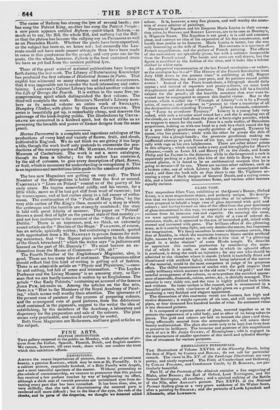EXHIBITIONS.
AMONG the recent importations of pictures, there is one of prominent -beauty, a genuine RAPHAEL, which may be seen at 35, Piccadilly. It is a cabinet picture, exquisitely finished, of a Holy Family with Angels, and a most beautiful specimen of the master. Without pretending to _the eabala.of connoisseurship, we venture to pronounce that this picture .has received a few profane touches by way of heightening its effect, although a thick coat of varnish prevents our uninitiated eyes from de- tecting every part that has been retouched. It has been done, also, so very skilfully, that the task of discriminating the restored parts is rendered still more difficult ; but in the blue of the eyes, the reds of the cheeks, and in parts of the draperies, we thought we detected added colour. It is, however, a very fine picture, and well worthy the atten- tion of every admirer of paintings.
Portraits of Napoleon and his Empress Maria Louisa in their corona.
tion robes, by GERARD and ROBERT LEFEVRE, are to be seen at Bentley's, 5, Wigmore Street. The Napoleon is not good ; it is cold and common place, and conveys no idea of the expression of his fine countenance, and hardly does justice to its features. Maria Louisa is better, but she was only interesting as the wife of Napoleon. Her costume is a specimen of French magnificence, and the picture of French painting. The effects of the embroidery are splendidly given, but with a coldness inseparable from the French school. The hands and arms are well drawn, but the figure is sacrificed to the fashion of the time, and it looks like a bolster clothed in white satin.
An allegorical representation of the last French revolution—or rather, as the catalogue has it—of" The History of the French Revolution trim July 1830 down to the present time," is exhibiting at 107, Regent Street. Historians, lay down your pens, and let painters record public events ! Instead of the Times broad-sheet, a lithograph should daily appear ; and instead of reporters and penny-a-liners, we must have draughtsmen and short-hand sketchers. The cholera will be a fruitful subject for the pencil ; all the horrible monsters that ever were in. vented may be congregated to express this fearful visitor. But to the picture, which is called the "Triumph of Liberty"—it is by a French artist, of course ; and professes to "present to view a transcript of all the destructive evils attending Tyranny." Liberty descends, command- ing "Force to overthrow Tyranny.' Liberty is a young lady very naked, with only a tri-color scarf round her; and she is stepping out of the clouds, on a round ball about the size of a forty.eight pounder, which we suppose is meant for the earth. Force is a male nudity, of Herculean proportions, holding on with one hand to a rock by a chain round the leg of a poor elderly gentleman equally guiltless of apparel, Tyranny by name, who lies prostrate ; while with the other he grasps the shin of Tyranny like a plough-handle ; the prostrate gentleman making an ineffectual attempt to push Force off his legs, and grinning very natu- rally with rage at his own helplessness. There are other minor points in this allegory ; which would make a very good hieroglyphic for Moore's Almanac,—such as Louis XI. and Henry IV. in the clouds, and Louis Philip and La Fayette in the distance ; while in the foreground a cock is apparently pecking at a jewel, like him of the fable in /Esop ; but on a second glance, it is found to be an emblematical scorpion that he is
going to devour—if he can. There are various other emblems, such as a broken yoke, one of which Liberty holds like an emancipated milk- maid ; and then the book tells us that there is one Mr. Vigilance ar- resting a corps of black designs of General Deceit, and a crying croco- dile, and a lamb vomiting bituminous flame, and various other matters. equally curious.


























 Previous page
Previous page